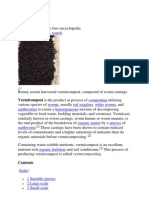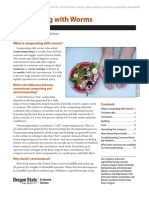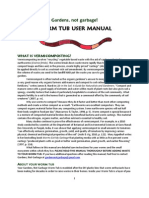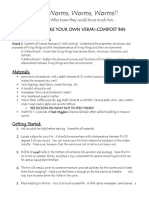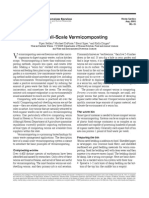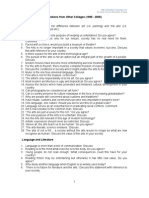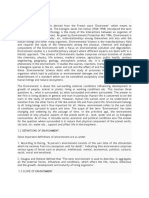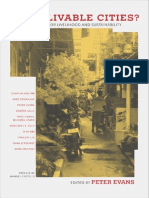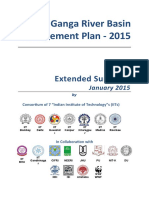Ve Micompo Ing: Indoo Compo Ing I H Eahom
Ve Micompo Ing: Indoo Compo Ing I H Eahom
Uploaded by
Zeus BalagtasCopyright:
Available Formats
Ve Micompo Ing: Indoo Compo Ing I H Eahom
Ve Micompo Ing: Indoo Compo Ing I H Eahom
Uploaded by
Zeus BalagtasOriginal Title
Copyright
Available Formats
Share this document
Did you find this document useful?
Is this content inappropriate?
Copyright:
Available Formats
Ve Micompo Ing: Indoo Compo Ing I H Eahom
Ve Micompo Ing: Indoo Compo Ing I H Eahom
Uploaded by
Zeus BalagtasCopyright:
Available Formats
Vemicompoing:
IndooCompoingih
Eahom
Vemicompoing:IndooCompoingih
Eahom
Composting is a controlled process oI decomposition
used to transIorm organic material such as kitchen
scraps, yard wastes and paper products into humus.
Humus, or compost, is a dark, soil-like substance that
enriches soil with nutrients, increases moisture
retention, improves structure and provides a good
environment Ior beneIicial soil organisms. Composting
is usually done outdoors, but the process can easily be
adapted Ior indoor use. So you can compost even iI
you don't have a yard, or iI you don't like going out to
a compost bin in the snow, or iI you want to produce
the highest quality compost there is: vermicompost!
Whaiemicompoing?
Vermicomposting is simply composting with
earthworms. Earthworms speed up the composting
process, aerate the organic material in the bin, and
enhance the Iinished compost with nutrients and
enzymes Irom their digestive tracts. The best kind oI
earthworms to use are red worms, also known as "red
wigglers" and "manure worms". These worms thrive in
decomposing organic matter such as leaI piles,
compost heaps and old manure piles. They are smaller
than nightcrawlers and are reddish brown in color. Red
worms are native to Europe but have become
naturalized throughout the U.S. Red worms are a good
indicator oI Iertile soil because their presence indicates
high organic matter content and a lack oI toxic
substances in soil.
Red worms make composting indoors Ieasible because
they are very eIIicient processors oI organic waste
they eat and expel their own weight every day. Even a
small bin oI red worms will yield pounds oI rich
compost, also known as worm castings. Finished
compost can be harvested in as little as two to three
months. Redworms are extremely proliIic. It takes
about three weeks Ior Iertilized eggs to develop in a
cocoon Irom which two or more young worms can
hatch. In three months the worms become sexually
mature and will start breeding. Within a year you'll be
able to give worms away to get a Iriend started! And
you'll never have to buy bait Ior trout Iishing again!
WheecanIgeaombin?
Worms and bins are also available Irom Cape Cod
Worm Farm, FlowerIield Enterprises, and Gardener's
Supply Company. The least expensive way to obtain a
worm bin is to make one Irom a plastic or wooden
container by drilling air holes in the sides and top.
Plastic containers can be purchased Irom a hardware or
department store. Get one with a lid. Since worms do
not like light, an opaque container is preIerable to a
translucent one, unless the bin is kept covered with a
dark cloth. The larger the container, the more material
you will be able to compost. A deep bin is preIerable
to a shallow one because it allows more room Ior
layering and burying Iresh material.
number oI
people
quantity oI
worms
bin size
1 or 2 1 lb.
15"h x 1.5'w x
2'l
2 or 3 1 lb. 15"h x 2'w x 2'l
4 to 6 2 to 3 lbs.
15"h x 2'w x
3.5'l
HodoIconehebinoaombin?
Drill holes approximately 3" apart in
the sides and cover oI the bin. The
holes should begin approximately 4"
Irom the bottom oI the bin. The holes
should not be wider than 1/8". Some guides
recommend drilling holes in the bottom oI the bin Ior
drainage, but this is optional. II you provide drainage
holes, you will need a tray to catch excess moisture. II
you do not provide drainage holes, you will need to
add extra dry material iI the bin starts to develop
puddles in the bottom. Red worms thrive in a very
damp environment (at least 50 moisture), but
puddled water will eventually result in odor Iormation.
HodoIpepaehebinfoheom?
First, you will need bedding Ior the
worms. Red worms can survive and
breed in many kinds oI bedding
materials. The worms eat the
bedding as it decomposes, turning it
to compost along with the kitchen
scraps you add. The bedding should
be a high carbon material, such as Iall leaves (best iI
small or shredded), shredded paper (such as
newspaper, paper towels, napkins, paper bags), ground
cardboard or peat moss, or a combination oI these
materials. II you use peat moss, make sure to mix it
with other bedding as it is too acidic to use alone.
Dampen the bedding until the moisture content is 50
(as damp as a wrung out sponge). It is important to
keep the bedding this damp or the worms will die. Mix
a Iew handIuls oI soil or Iinished compost with the
bedding. The bedding should Iill the bin about 3/4 Iull.
Vegetative wastes are buried underneath the bedding,
which Iilters out any odors Irom the decomposing
material below. The whole mixture will turn to
compost in about 3 months. Now it's time to add the
worms!
WheecanIgeRedom?
See the suppliers noted above. You may also Iind a
commercial source oI redworms in your area by
checking the Yellow Pages under the heading "Fishing
Bait." Be sure to ask Ior redworms or red wigglers.
In nature, redworms can be Iound in decaying leaves,
manure piles or other organic material, such as
compost piles. II you have access to such areas, you
can collect your own redworms. A Iew handIuls are
enough to start a bin, but add only small amounts oI
Iood scraps until the worm population increases
enough to handle more (3-4 months).
WhadoIfeedhem?
Worms will eat just about any type oI kitchen waste
including vegetables, Iruits, coIIee grounds, tea bags
and egg shells (crushed). Do not add meat or meat
byproducts. Bury the Iood scraps completely, so that
they are always covered by bedding this prevents
development oI odors and Iruit Ilies. Don't add more
Iood scraps than the worms eat in several days. The
worms can't eat the Iood until it starts to decompose,
so it may take a Iew months Ior the bin to get up to
speed. For Iastest decomposition, chop the Iood scraps
into small pieces.
Canomlieoidedingcoldemonh?
Worms preIer temperatures between 40 and 80 degrees
Fahrenheit. II you live in an apartment building they
can live quite happily out on the balcony until
temperatures drop to 40 degrees. AIter that they should
be taken indoors. Basements or garages that don't
Ireeze are good locations Ior worm bins.
HodoIhaehefinihedcompo?
AIter about 3 months you'll notice that the volume oI
materials has dropped substantially and the original
bedding is no longer recognizable. At this point the
Iinished compost and worms can be moved over to one
side oI the bin and new bedding added to the vacant
side. Put new Iood wastes into the Iresh bedding only,
so the worms will move Irom the Iinished compost in
search oI new Iood. AIter two weeks or so remove the
lid under a bright light source. The worms are sensitive
to light and will burrow away Irom it. Scoop out the
Iinished compost a Iew layers at a time and place in a
plastic bag or container until you're ready to use it.
Latex gloves are very convenient Ior this task. Now
add Iresh bedding and the process begins again!
HocanIehefinihedcompo?
Vermicompost, or worm castings, provides nutrients to
your plants and helps the soil hold moisture. Growth
trials indicate vermicompost has a more beneIicial
eIIect on plants than compost produced without
worms, although the reasons Ior this are still not
entirely understood. Vermicompost can be used in a
number oI diIIerent ways:
1. Mix it into the seed row when planting.
2. When transplanting, add a handIul oI
vermicompost to the hole you have dug Ior the
plant.
3. Use as a top dressing, placing a layer oI
vermicompost around the base oI plants (but not
in contact with the stems).
4. Mix with potting soil and sand (1/3rd each) Ior
house plants.
5. Give a quart away (with the worms still in it) to
someone else who wants to start
vermicomposting.
Excerpted Irom: WormsEatMGarbageby Mary
AppelhoI
Other useIul books:
TheRodaleGuidetoComposting (Rodale Press)
LetItRot! (Storey Publishing)
There is also useIul inIormation at:
http://www.howtocompost.org/wormcomposting.asp
Franklin County Solid Waste Management District
50 Miles Street
GreenIield, MA 01301
Tel: (413) 772-2438
MA Relay Ior the hearing impaired: 711 or 1-800-439-
2370 (TTY/TDD)
Fax: (413) 772-3786
StaII email addresses
This website is made possible through a grant Irom
the
USDA Rural Utilities Service.
FCSWMD is an equal opportunity provider.
Full Equal Opportunity Disclosure Statement.
Excerpted Irom Vermicomposting:IndoorCompostingwithEarthworms
http://www.Iranklincountywastedistrict.org/vermicomposting.html
READABILITY An Arc90 Laboratory Experiment
http://lab.arc90.com/experiments/readability
You might also like
- JackwolfskinDocument27 pagesJackwolfskinRahul AnandNo ratings yet
- 4.3.8 Write - Prepare A Revision of A Procedural Document (Reading Materials)Document5 pages4.3.8 Write - Prepare A Revision of A Procedural Document (Reading Materials)Godfrey ByaombeNo ratings yet
- Vegan Dog Food Marketing AssignmentDocument19 pagesVegan Dog Food Marketing AssignmentPalak Iqbal SinghNo ratings yet
- Know Your Soil PDFDocument20 pagesKnow Your Soil PDFbpcdivNo ratings yet
- Wormlovers Top TipsDocument1 pageWormlovers Top TipsFrikkie Le GrangeNo ratings yet
- How To Compost With WormsDocument2 pagesHow To Compost With WormsGreater Charlotte Harbor Sierra ClubNo ratings yet
- PP5804 Term Paper - I Vybhav DharDocument6 pagesPP5804 Term Paper - I Vybhav DharVybhav DharNo ratings yet
- Mealworms From Farm To TableDocument23 pagesMealworms From Farm To TableMian Rizwan ZebNo ratings yet
- Larvae 3Document81 pagesLarvae 3Kenaia AdeleyeNo ratings yet
- Microbe On Argiculture PDFDocument34 pagesMicrobe On Argiculture PDFNEILYNo ratings yet
- Verm I CompostDocument34 pagesVerm I CompostbhabaniNo ratings yet
- Navigation Search: VermicompostDocument11 pagesNavigation Search: VermicompostSanchit AggarwalNo ratings yet
- Worm CompostingDocument13 pagesWorm CompostingVin100% (3)
- Flea ControlDocument4 pagesFlea ControlwandererNo ratings yet
- Raw MilkDocument3 pagesRaw MilkManezay100% (1)
- Humic Foliar Application As Sustainable Technology For Improving The Growth, Yield, and Abiotic Stress Protection of Agricultural Crops. A ReviewDocument21 pagesHumic Foliar Application As Sustainable Technology For Improving The Growth, Yield, and Abiotic Stress Protection of Agricultural Crops. A ReviewTomas FloresNo ratings yet
- Municipal Solid Waste Management Through Vermicomposting Employing Exotic and Local Species of EarthwormsDocument5 pagesMunicipal Solid Waste Management Through Vermicomposting Employing Exotic and Local Species of EarthwormsFikri Al TamamiNo ratings yet
- Top 8 Disadvantages of Compost TeaDocument14 pagesTop 8 Disadvantages of Compost Teaakshay100% (1)
- Drip Irrigation TutorialDocument34 pagesDrip Irrigation TutorialAziz Khan KakarNo ratings yet
- Crafting the Sale: Drive Revenue, Impress Buyers, and Transform Your CareerFrom EverandCrafting the Sale: Drive Revenue, Impress Buyers, and Transform Your CareerNo ratings yet
- Constructing A Worm Compost Bin - University of KentuckyDocument5 pagesConstructing A Worm Compost Bin - University of KentuckyPennsylvania Association for Sustainable AgricultureNo ratings yet
- Shedd Worm BrochureDocument12 pagesShedd Worm BrochureDouglas RezendeNo ratings yet
- GNG Worm Tub ManualDocument8 pagesGNG Worm Tub ManualhzydekNo ratings yet
- Vermicomposting: The Worms and Other Worm Bin OrganismsDocument4 pagesVermicomposting: The Worms and Other Worm Bin OrganismsDell Delimano100% (1)
- Composting: Composting Turns Household Wastes Into Valuable Fertilizer and Soil Organic Matter. in Your GardenDocument6 pagesComposting: Composting Turns Household Wastes Into Valuable Fertilizer and Soil Organic Matter. in Your GardenCharles MasonNo ratings yet
- Composting With WormsDocument4 pagesComposting With WormsmevlsiautmduNo ratings yet
- BI103 Practical 6 HandoutDocument3 pagesBI103 Practical 6 HandoutStephane FongNo ratings yet
- Back Yard Composting: What Can I Compost? Compost BinsDocument4 pagesBack Yard Composting: What Can I Compost? Compost BinsDell DelimanoNo ratings yet
- Worms Can Recycle Your Garbage-1 1996Document6 pagesWorms Can Recycle Your Garbage-1 1996soulshineta2No ratings yet
- Biology Investigatory Project: Done by R.Sudarshini Xii - ADocument20 pagesBiology Investigatory Project: Done by R.Sudarshini Xii - ASukirthika Ramakoti Krish Krish100% (3)
- Verm I CultureDocument2 pagesVerm I CulturelorryNo ratings yet
- Worm Composting - Montgomery ExtensionDocument2 pagesWorm Composting - Montgomery ExtensionPennsylvania Association for Sustainable AgricultureNo ratings yet
- How To Make CompostDocument3 pagesHow To Make Compostinsawflondt8958No ratings yet
- Indoor Composting With A Worm BinDocument0 pagesIndoor Composting With A Worm Binfarnaz_2647334No ratings yet
- Vermi CompostDocument30 pagesVermi CompostRaY Jay100% (1)
- Composting and Worm Farming: Nature's Recycling SystemDocument8 pagesComposting and Worm Farming: Nature's Recycling SystemGreater Charlotte Harbor Sierra ClubNo ratings yet
- What Do Worms Eat - It All Depends On Where They LiveDocument3 pagesWhat Do Worms Eat - It All Depends On Where They Liveronalit malintadNo ratings yet
- Vermi CompostingDocument24 pagesVermi CompostingDrTapas MallickNo ratings yet
- How To Set-Up and Manage A Stationary Backyard Compost BinDocument5 pagesHow To Set-Up and Manage A Stationary Backyard Compost BinLisa BoudemanNo ratings yet
- A Worm's Eye View of Composting - Organic Trade AssociationDocument6 pagesA Worm's Eye View of Composting - Organic Trade AssociationPennsylvania Association for Sustainable AgricultureNo ratings yet
- Growing Button Mushrooms at Home - A Full Guide - Gardening TipsDocument15 pagesGrowing Button Mushrooms at Home - A Full Guide - Gardening TipsMutaman SiddigNo ratings yet
- Vermiculture Basics & Vermicompost Working Draft3Document6 pagesVermiculture Basics & Vermicompost Working Draft3mracneaNo ratings yet
- Worm Compost InstructionsDocument2 pagesWorm Compost Instructionskurk80No ratings yet
- Home Composting: Getting StartedDocument5 pagesHome Composting: Getting StartedOliver ChildNo ratings yet
- A Guide To Composting - To Print 2021Document16 pagesA Guide To Composting - To Print 2021Deborah100% (1)
- Responsibility & How To Set It UpDocument5 pagesResponsibility & How To Set It UpLina ChakerNo ratings yet
- Portabella Growing InstructionsDocument4 pagesPortabella Growing InstructionsallentoddNo ratings yet
- Solid Organic Waste Composting.: By: Arshi Khan Avantika Agarwal Kirtee SinghDocument22 pagesSolid Organic Waste Composting.: By: Arshi Khan Avantika Agarwal Kirtee SinghArshi KhanNo ratings yet
- Garden Seed Handbook Part 4Document5 pagesGarden Seed Handbook Part 4gezarolNo ratings yet
- VermicompostingDocument4 pagesVermicompostingmobyelectraNo ratings yet
- Composting Guide For BeginnersDocument5 pagesComposting Guide For BeginnersJohn DoverNo ratings yet
- Vermiculture Composting WormsDocument1 pageVermiculture Composting WormsAllan MedallaNo ratings yet
- Information Sheet 3.1-1Document13 pagesInformation Sheet 3.1-1cristinjeanomboyNo ratings yet
- Lesson 5-8Document40 pagesLesson 5-8Marife CulabaNo ratings yet
- DIY Worm FarmDocument2 pagesDIY Worm FarmAloysius Dooty Doot SkulltrumpetNo ratings yet
- Compost Turn Your Trash Into TreasureDocument9 pagesCompost Turn Your Trash Into TreasurejavalassieNo ratings yet
- MV Worm CompostingDocument2 pagesMV Worm CompostingLeigh LeiNo ratings yet
- 3 Different Compost Making Techniques (And The Advantages of Each)Document5 pages3 Different Compost Making Techniques (And The Advantages of Each)akshayNo ratings yet
- Eastern Thailand - Jon Jandai - Farmer, Builder and Man of LeisureDocument3 pagesEastern Thailand - Jon Jandai - Farmer, Builder and Man of Leisuregl101No ratings yet
- East Irondequoit Middle School Sciences 7.2 Matter and Energy in Organisms and Ecosystems EcologyDocument10 pagesEast Irondequoit Middle School Sciences 7.2 Matter and Energy in Organisms and Ecosystems EcologyMuhammad IqbalNo ratings yet
- Building Ecology (Building Science)Document38 pagesBuilding Ecology (Building Science)Quah Qiu YuNo ratings yet
- GP - Essay Questions Collection From Past PrelimsDocument8 pagesGP - Essay Questions Collection From Past Prelimshelixate100% (16)
- Essays UKDocument4 pagesEssays UKManan KhuranaNo ratings yet
- EAP584 EnvRiskAssessDocument44 pagesEAP584 EnvRiskAssessZulham RizanurNo ratings yet
- Higgs 2003 - Nature by Design - People, Natural Process and Ecological RestorationDocument3 pagesHiggs 2003 - Nature by Design - People, Natural Process and Ecological RestorationGuilherme PradoNo ratings yet
- Lecture 03 (Ecosystem)Document15 pagesLecture 03 (Ecosystem)osmanmahdy19No ratings yet
- Enerscapes: Territory, Landscape and Renewable EnergiesDocument50 pagesEnerscapes: Territory, Landscape and Renewable EnergiesMichela GhislanzoniNo ratings yet
- Microbial Ecosystem Narrative ReportDocument4 pagesMicrobial Ecosystem Narrative ReportJeane Klaire ObadoNo ratings yet
- Group 4 Intergrated Pest ManagementDocument10 pagesGroup 4 Intergrated Pest ManagementLennon T MuchanganiNo ratings yet
- ĐỀ THI ANH VĂN CHUYÊN HỌC KỲ 2 LỚP 10Document4 pagesĐỀ THI ANH VĂN CHUYÊN HỌC KỲ 2 LỚP 10Quang Minh100% (1)
- IAS Geography Optional Analysis Biogeography Questions 1991 OnwardsDocument2 pagesIAS Geography Optional Analysis Biogeography Questions 1991 OnwardsAbinesh TNo ratings yet
- Youth and Ecological Restoration Project: Queen Alexandra Foundation For ChildrenDocument10 pagesYouth and Ecological Restoration Project: Queen Alexandra Foundation For ChildrenPieter VorsterNo ratings yet
- Wollo UniversityDocument57 pagesWollo UniversityTadele TilahunNo ratings yet
- Triggers For ChangeDocument5 pagesTriggers For Changesanthu_bhoomi9673100% (1)
- Environment Law ProjectDocument31 pagesEnvironment Law ProjectAmulya KaushikNo ratings yet
- Admission Brochure For PHD Admission Test: First Semester 2014-15 IndexDocument13 pagesAdmission Brochure For PHD Admission Test: First Semester 2014-15 IndexAnjnaKandariNo ratings yet
- Organic Vegetable Farming: A ComicsDocument48 pagesOrganic Vegetable Farming: A ComicsFoundation for a Sustainable Society100% (2)
- Environmental Law AssignmentDocument4 pagesEnvironmental Law AssignmentBO-Manipur NHIDCLNo ratings yet
- Resource and DevelopmentDocument6 pagesResource and DevelopmentvrajNo ratings yet
- STS - MODULE7 - Biodiversity and Healthy SocietyDocument14 pagesSTS - MODULE7 - Biodiversity and Healthy SocietyJodel Bautista Doria100% (2)
- Peter Evans, Ed. Livable Cities - Urban Struggles For Livelihood and Sustainability 2002Document291 pagesPeter Evans, Ed. Livable Cities - Urban Struggles For Livelihood and Sustainability 2002Juanma Valdés100% (1)
- The Study of Zooplankton Community Diversity in Zaghen Restored WetlandDocument6 pagesThe Study of Zooplankton Community Diversity in Zaghen Restored WetlandAlexandra GeorgianaNo ratings yet
- Facts About Ecological ImbalanceDocument4 pagesFacts About Ecological ImbalanceSIKHA A SNo ratings yet
- Ecosystem - Module 2Document32 pagesEcosystem - Module 2SiddhanthJainNo ratings yet
- The Value of Birds: Ecological and Economic Importance of Birds To HumanityDocument16 pagesThe Value of Birds: Ecological and Economic Importance of Birds To HumanityYilma Dellelegn Abebe33% (3)
- RPP Bhs Inggris Kelas IX KD 8.2 SMT IIDocument4 pagesRPP Bhs Inggris Kelas IX KD 8.2 SMT IIkomaNo ratings yet
- Dynamics of DevelopmentDocument59 pagesDynamics of DevelopmentRenzelle Dela Cruz Chiong100% (1)
- GRBMP - Extended SummaryDocument43 pagesGRBMP - Extended SummaryRakesh MishraNo ratings yet











